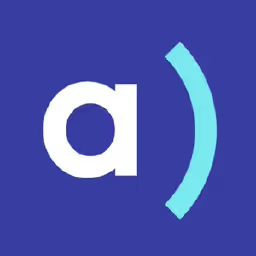Pick Alternatives
Considering a switch from Pick? We analyze 10 alternatives, detailing their core differences to help you make an informed decision.
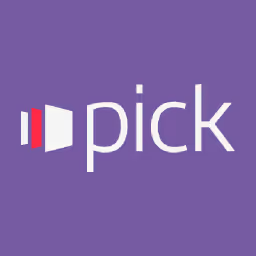
You might be using Pick for good reasons. It’s a reliable, easy-to-use lone worker solution that works on existing smartphones. Its ability to send alerts from areas with low signal is a key strength for ensuring employee safety.
But every tool has its limits. Some find that the lack of public reviews and pricing information makes evaluation difficult. We've analyzed the top alternatives to help you shortlist the best options for your company. Let's get started.
Consider 11x for Your Sales Team
If your focus includes sales operations, consider 11x. It provides digital workers to manage sales tasks from lead research to initial contact. This lets your sales staff concentrate on final negotiations and closing deals.
11x is a GTM platform that uses AI agents to automate the sales process. Its AI agent, Alice, finds prospects, manages outreach on email and LinkedIn, and maintains your CRM. A second agent, Julian, qualifies inbound leads and books meetings.
The platform consolidates functions like data enrichment, outreach, and email warmup. This removes the need for multiple separate tools within a GTM stack.
Pick Alternatives
We will now review the top alternatives to Pick in detail. This analysis covers each solution's pricing, core features, and specific advantages and disadvantages to help you find the right fit for your organization.
1) Calendly
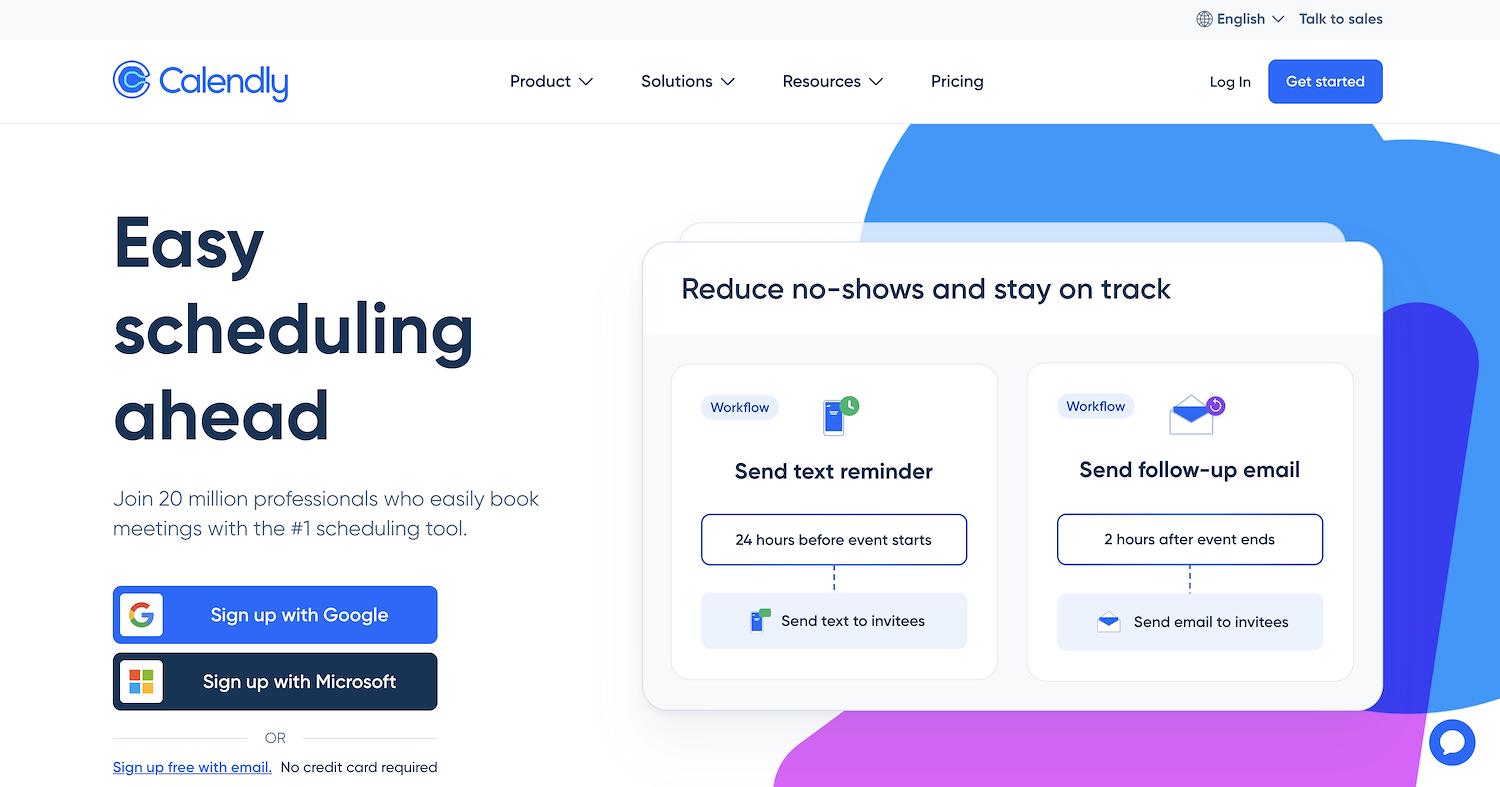
Calendly is a schedule automation platform that ends back-and-forth emails. Users share real-time availability via personalized links or embedded calendar widgets. The tool connects to multiple calendars and integrates with over 100 business apps.
It is used for client appointments, sales lead qualification, and recruiting interviews. The platform also automates reminders to reduce no-shows and helps with internal team syncs. Over 100,000 organizations use it.
Calendly's Main Features
- Syncs with up to six calendars, including Google and Outlook, to show real-time availability.
- Sends automated SMS or email reminders and post-meeting follow-ups.
- Uses routing forms to qualify and direct leads from a website before presenting booking times.
- Integrates with over 100 business applications such as Salesforce, HubSpot, and Slack.
How Calendly Compares to Pick
Average Review score: 4.7/5 stars based on 2,399 G2 reviews.
- Calendly automates the meeting scheduling process by letting users share availability links. This function is different from Pick, which focuses on lone worker safety alerts.
- It connects with up to six calendars, such as Google and Outlook, to show true availability and prevent double bookings. Pick does not offer calendar synchronization.
- The platform sends automated reminders and follow-up messages for appointments. This contrasts with Pick’s alert system, which is designed for safety incidents.
- This tool integrates with over 100 business apps like Salesforce and HubSpot to support sales and marketing workflows, a capability not found in Pick.
Where Calendly Falls Short Compared to Pick
- Calendly does not provide lone worker safety monitoring. It lacks the alert systems found in Pick, which are designed to protect employees working alone or in remote areas.
- The platform depends on a stable internet connection for all its functions. This can be a limitation compared to Pick, which has features designed to work in areas with low signal strength.
- Its primary function is appointment scheduling, not employee safety. For companies that need to track and protect staff, this focus is a major departure from Pick's core safety offerings.
Pricing and Cost-Effectiveness
Pick does not publish its pricing, so customers must request a quote. In contrast, Calendly offers a free plan for basic scheduling, with paid tiers starting at $10 per seat per month for additional features.
2) Doodle
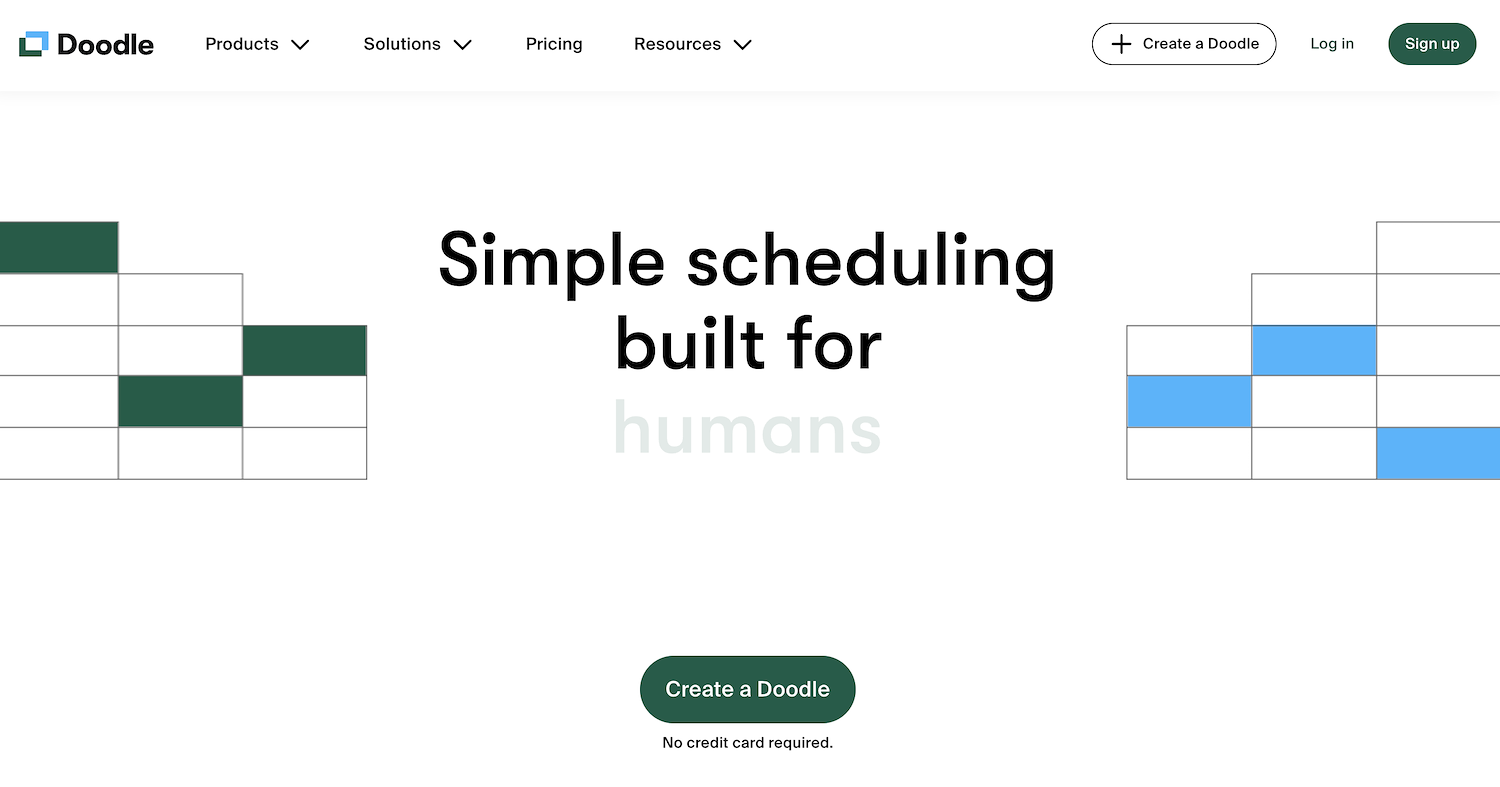
Doodle is an online platform to schedule meetings. Users create invitations or booking pages so participants can choose a time. The service has enterprise-level security and is used by over 70,000 companies to arrange more than two million meetings each month.
Common uses include recruitment interviews, board meetings, and sales calls. The platform helps align executive calendars and lets prospects self-book demos.
Doodle's Main Features
- Offers multiple scheduling workflows, including group polls, 1:1 scheduling, and booking pages.
- Automatically creates calendar events and adds video conference links for platforms like Zoom, Microsoft Teams, and Google Meet.
- Allows users to collect payments at the time of booking through an integration with Stripe.
- Provides sign-up sheets for people to claim slots for workshops, webinars, or other events.
How Doodle Compares to Pick
Average Review score: 4.4/5 stars based on 2,064 G2 reviews.
- Doodle offers group polls for participants to vote on the best meeting time. This scheduling feature is not available in Pick, which focuses on safety alerts.
- It provides booking pages that show real-time availability from connected calendars. Pick does not offer calendar integration for scheduling purposes.
- The tool automatically adds video conference links from services like Zoom and Microsoft Teams to calendar events, a function not found in the Pick safety platform.
- Users can collect payments at the time of booking through a Stripe integration. This capability is outside the scope of Pick's safety-oriented system.
Where Doodle Falls Short Compared To Pick
- Doodle does not have a system for emergency alerts. This is different from Pick, which is designed specifically to send notifications for safety incidents that involve lone workers.
- Its functionality may be limited in areas with poor connectivity. Pick, in contrast, includes features that allow it to operate and send alerts even when the signal is weak.
- The tool is built to organize schedules, not for personnel tracking or protection. Companies that need to monitor employee location for safety will find this a major difference from Pick's capabilities.
Pricing and Cost-Effectiveness
Pick requires a custom quote, while Doodle offers transparent pricing with a free plan and paid tiers starting at $6.95 per user per year. This makes Doodle's costs easier to assess upfront. For the latest pricing, visit Doodle's official website.
3) OnceHub
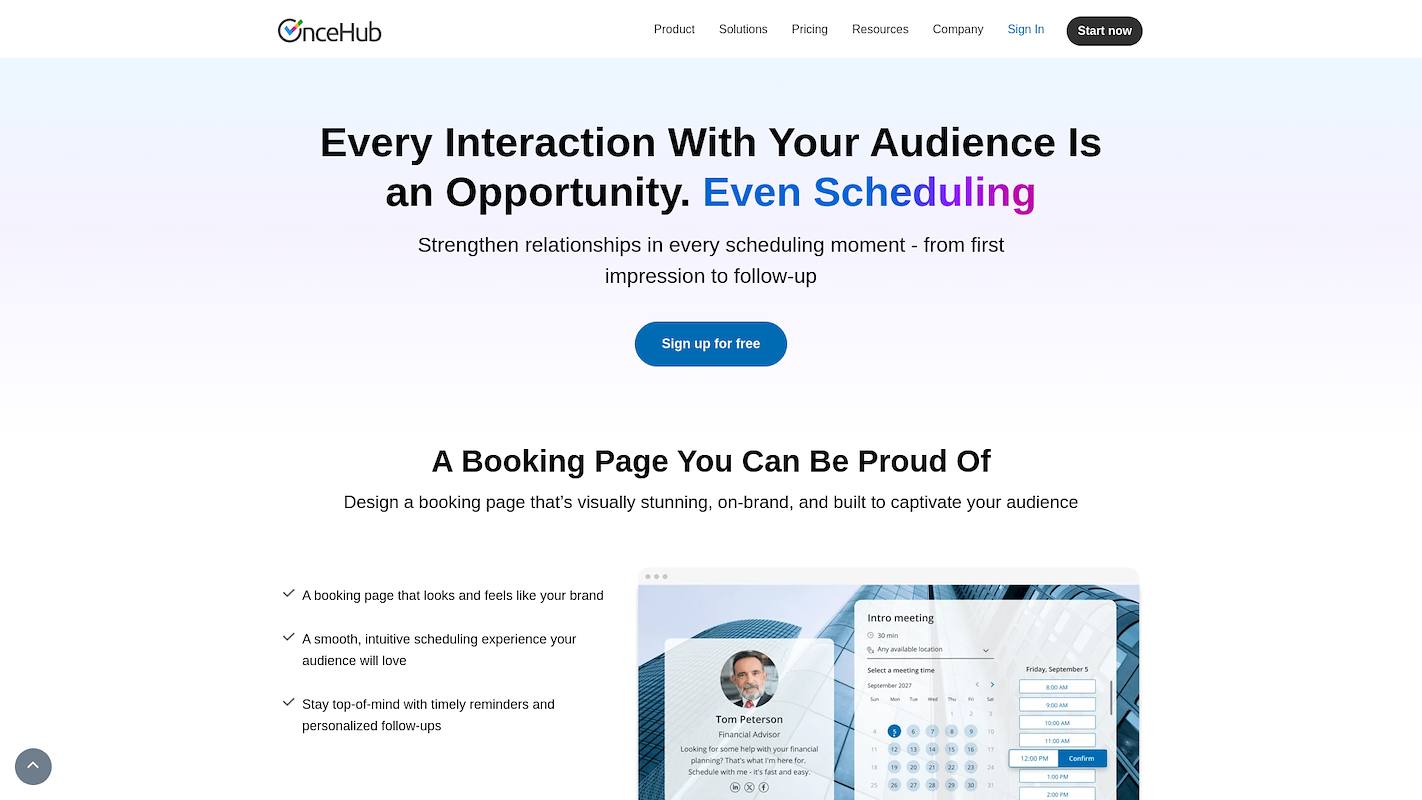
OnceHub is a cloud-based scheduling platform. It uses AI conversational flows and smart routing to match inquiries with the correct person. The system supports sales, service delivery, support, and recruitment.
It works for both online and in-person meetings and provides visually branded pages to book appointments. The platform is backed by enterprise-grade security and compliance for various standards, including GDPR, HIPAA, and SOC2.
OnceHub's Main Features
- Uses AI-driven conversational scheduling to assess the urgency and purpose of a meeting request.
- Provides routing and distribution rules to match inquiries with the correct team member or calendar.
- Supports multi-location and hybrid work by combining calendars and coordinating meeting rooms.
- Integrates with over 100 native and Zapier applications, including Salesforce, Microsoft 365, and Zoom.
How OnceHub Compares to Pick
Average Review score: 4.3/5 stars based on 52 G2 reviews.
- OnceHub uses AI to route inquiries to the correct team member based on urgency and purpose. This differs from Pick, which focuses on safety alerts and lacks automated lead distribution.
- The tool supports complex scheduling for hybrid teams by coordinating calendars and meeting rooms. Pick does not include any calendar or resource management functions.
- It provides chatbots and online forms to capture and qualify leads directly from a website. In contrast, Pick is a safety platform without customer engagement or lead capture tools.
- This platform connects with over 100 business applications like Salesforce and Zoom. Pick does not offer these integrations, as its design serves employee safety, not business workflows.
Where OnceHub Falls Short Compared To Pick
- OnceHub does not provide lone worker safety monitoring. This is different from Pick, which has an alert system to protect employees who work alone or in remote areas.
- Its functionality depends on a stable internet connection. This can be a limitation compared to Pick, which has features designed to work in areas with low signal strength.
- The platform's primary function is appointment scheduling, not employee safety. For companies that need to track and protect staff, this focus is a major departure from Pick's core safety offerings.
Pricing and Cost-Effectiveness
Pick requires a custom quote, making its pricing opaque. In contrast, OnceHub offers a free starter plan for up to three users and a paid tier at $10 per user per month. For detailed pricing, visit OnceHub's official website.
4) Acuity Scheduling

Acuity Scheduling is an online appointment scheduler. It gives businesses a way to manage calendars and lets clients book appointments directly. The platform automates client intake, sends reminders, and processes payments through its system.
It is for service-based businesses that need to schedule appointments, classes, or private sessions. The tool helps organize schedules and reduces administrative tasks for business owners.
Acuity Scheduling's Main Features
- Provides branded scheduling pages that allow clients to book, cancel, or reschedule appointments.
- Collects secure payments through Stripe, Square, and PayPal, with options for deposits and tipping.
- Includes loyalty-building tools such as coupons, discounts, subscriptions, and gift cards.
- Gathers client information with custom intake forms and stores it in client profiles.
How Acuity Scheduling Compares to Pick
Average Review score: 4.7/5 stars based on 404 G2 reviews.
- Acuity Scheduling processes payments through Stripe, Square, and PayPal. This function supports service businesses, unlike Pick, which is built for employee safety.
- It uses custom intake forms to collect client information before appointments. Pick does not offer client data collection, as its purpose is safety monitoring.
- The platform provides branded scheduling pages to match a company's visual identity. This is different from Pick's interface, which is focused on safety alert functionality.
- This tool includes loyalty features such as coupons and gift cards. Pick is a safety solution and does not have similar marketing or customer retention tools.
Where Acuity Scheduling Falls Short Compared To Pick
- Acuity Scheduling does not provide lone worker safety features. This is a major difference from Pick, which is designed to send alerts and protect employees who work by themselves.
- The tool depends on a stable internet connection for its scheduling functions. This can be a limitation in remote locations, while Pick has features that work in areas with low signal.
- Its platform is built for managing appointments, not for employee safety. Companies that need to monitor staff location for protection will find this a departure from Pick's core purpose.
Pricing and Cost-Effectiveness
Pick requires a custom quote, making its pricing opaque. Acuity Scheduling offers transparent, tiered plans starting at $16 per month, which makes its costs easier to evaluate upfront.
5) Chili Piper
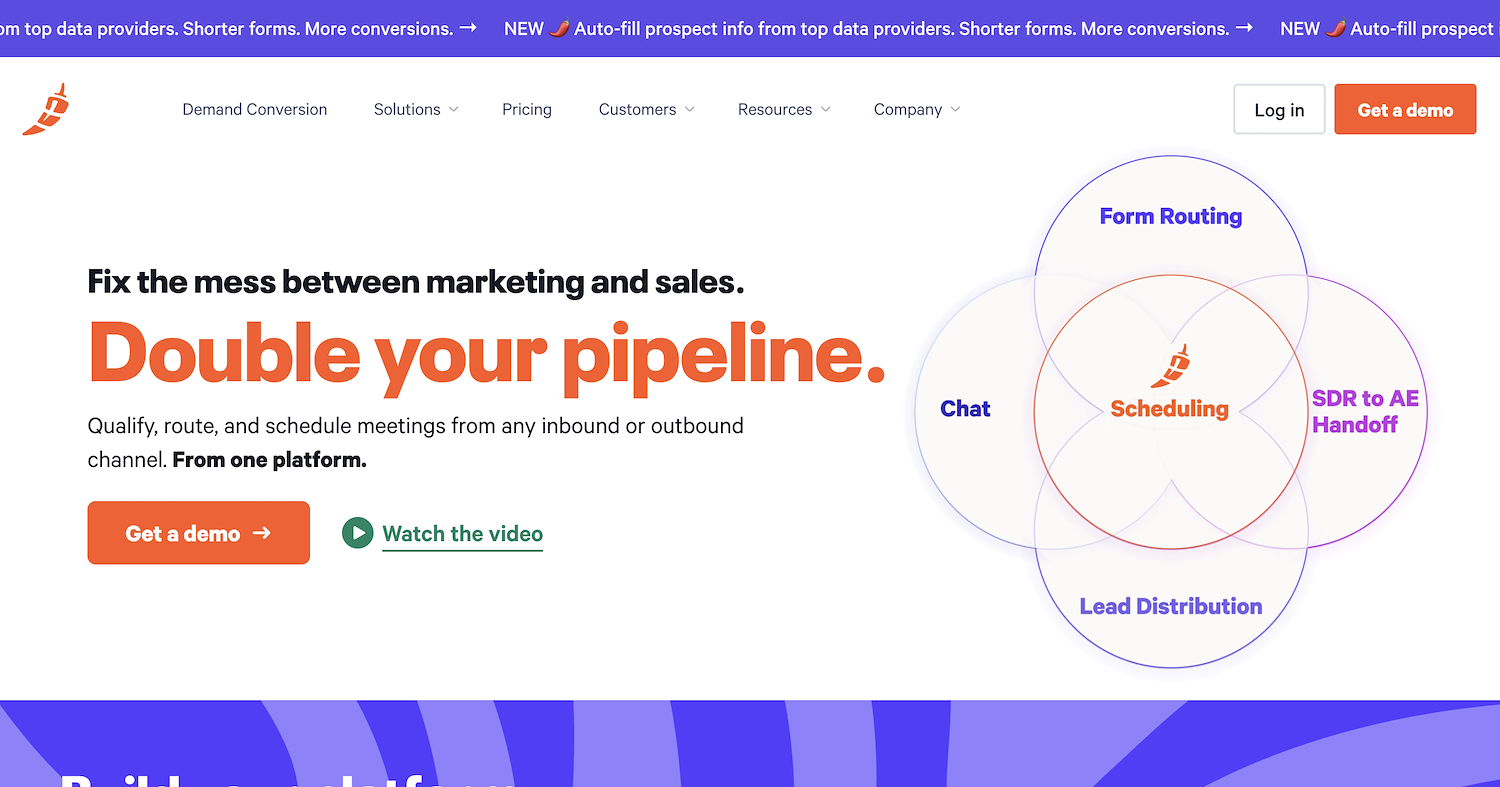
Chili Piper is a platform for revenue teams to convert inbound leads. It qualifies and routes prospects from web forms to the correct representative for an instant meeting. The system helps sales teams book appointments directly from a company's website or marketing campaigns.
Chili Piper's Main Features
- Qualifies prospects from web forms, routes them to the correct representative, and allows for self-booking.
- Automates the distribution of Salesforce records based on predefined rules, ownership, and service-level agreements.
- Manages the assignment and scheduling from SDRs to AEs, including fairness and no-show management.
- Uses automated playbooks and live chat to route website visitors or let them schedule meetings within the chat window.
How Chili Piper Compares to Pick
Average Review score: 4.6/5 stars based on 688 G2 reviews.
- Chili Piper routes leads from web forms to the correct sales representative. Pick is a safety platform and does not include lead management tools.
- It allows prospects to book meetings instantly from a company's website. This scheduling function is not available in Pick, which focuses on safety alerts.
- The tool automates the handoff between team members, like from a sales development rep to an account executive. Pick is designed for individual worker safety, not internal team coordination.
- This platform connects with CRMs like Salesforce to log meeting activities automatically. Pick operates as a safety tool and lacks these software integrations.
Where Chili Piper Falls Short Compared To Pick
- Chili Piper provides no features for lone worker safety. This is a key difference from Pick, which is a platform designed specifically to send alerts and protect employees who work by themselves.
- The tool's scheduling and routing functions depend on a stable internet connection. This might be a limitation in remote locations, whereas Pick includes features that allow it to operate with a weak signal.
- Its primary purpose is to convert leads and schedule meetings for sales teams. It does not offer employee monitoring for safety, which is the core function of the Pick platform.
Pricing and Cost-Effectiveness
Pick requires a custom quote, making its pricing opaque. Chili Piper offers transparent pricing with plans starting at $15 per user per month, which makes its costs easier to evaluate upfront.
Use 11x for Sales Automation
For companies focused on sales productivity, 11x provides digital workers for lead generation and outreach. This lets your sales staff concentrate on high-value activities like negotiations and final deal closure. Explore 11x to see how it can support your sales operations.
With 11x, we use AI to run your sales playbook. Alice finds accounts and starts outreach, while Julian qualifies prospects and schedules meetings. The platform combines functions like intent data and email warmup, so you do not need multiple GTM tools.
Book a demo to see it in action.
6) Setmore

Setmore is an online platform for appointment schedules. It offers a custom page where clients can book appointments or classes on their own time. Businesses use it to organize staff calendars, handle client information, and send automated reminders before a scheduled service.
Setmore's Main Features
- Provides a custom booking page that can be embedded on websites, Facebook, and Instagram for direct scheduling.
- Accepts online payments and deposits through integrations with Stripe, Square, or PayPal.
- Offers two-way calendar synchronization with Google and Office 365 to show real-time availability and prevent double-booking.
- Automatically adds one-click Zoom or Google Meet links to relevant bookings for virtual meetings.
How Setmore Compares to Pick
Average Review score: 4.5/5 stars based on 267 G2 reviews.
- Setmore provides a custom booking page that can be embedded on websites and social media for direct scheduling. Pick is a safety platform and does not offer client-facing booking features.
- The tool accepts online payments through integrations with Stripe, Square, and PayPal. This is different from Pick, which has no payment processing capabilities.
- It offers two-way calendar synchronization with Google and Office 365 to show real-time availability. Pick does not have calendar integration, as its focus is on lone worker safety.
- This platform automatically adds one-click Zoom or Google Meet links to virtual appointments. This feature is not present in Pick, which is designed for safety monitoring, not meeting logistics.
Where Setmore Falls Short Compared to Pick
- Setmore does not provide lone worker safety features. This is a major difference from Pick, which is designed to send alerts and protect employees who work by themselves.
- The tool depends on a stable internet connection for its scheduling functions. This can be a limitation in remote locations, while Pick has features that work in areas with low signal.
- Its platform is built for managing appointments, not for employee safety. Companies that need to monitor staff location for protection will find this a departure from Pick's core purpose.
Pricing and Cost-Effectiveness
Pick requires a custom quote, so its pricing is not public. In contrast, Setmore offers transparent pricing with a free plan and paid tiers starting at $9 per month. This approach makes Setmore's costs easier to assess for budget planning.
7) SimplyBook.me
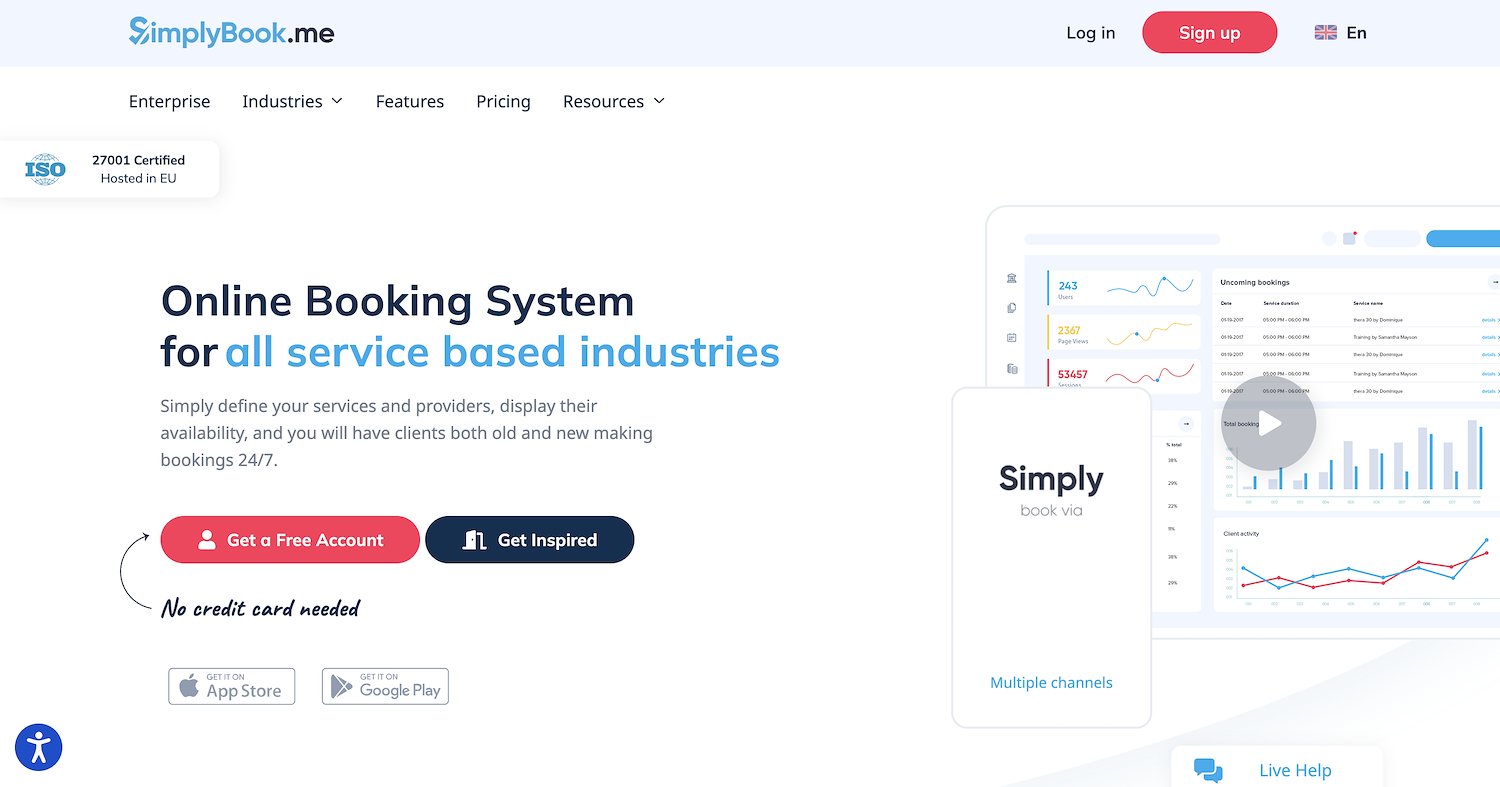
SimplyBook.me is an online appointment system for service-based companies. It provides a custom website for clients to book appointments 24/7. The platform serves many industries, such as beauty, wellness, and education. Businesses use it to organize their schedules and accept client appointments through their website or social media pages.
SimplyBook.me's Main Features
- Provides a mobile-optimized booking website and allows clients to book through channels like Facebook, Instagram, and Google.
- Sends automated booking confirmations and reminders to clients via SMS, email, WhatsApp, and Telegram.
- Accepts online and in-store payments through integrations with Stripe and PayPal, supporting methods like Apple Pay and Google Pay.
- Offers over 50 custom features that can be enabled as needed, including coupons, memberships, and HIPAA-compliant intake forms.
How SimplyBook.me Compares to Pick
Average Review score: 4.4/5 stars based on 105 G2 reviews.
- SimplyBook.me provides a dedicated booking webpage for clients to schedule appointments, which is different from Pick's focus on internal safety alerts for employees.
- It sends automated SMS and email reminders for appointments, whereas Pick uses its alert system for safety incidents, not for scheduling.
- The tool accepts online payments and can sell gift cards, a commercial function not found in the Pick safety platform.
- This platform integrates with client-facing channels like Facebook and Instagram for direct booking, unlike Pick, which operates as a standalone safety application.
Where SimplyBook.me Falls Short Compared To Pick
- SimplyBook.me does not provide lone worker safety features. This is a major difference from Pick, which is designed to send alerts and protect employees who work by themselves.
- The tool depends on a stable internet connection for its scheduling functions. This can be a limitation in remote locations, while Pick has features that work in areas with low signal.
- Its platform is built for managing appointments, not for employee safety. Companies that need to monitor staff location for protection will find this a departure from Pick's core purpose.
Pricing and Cost-Effectiveness
Pick requires a custom quote, making its pricing opaque. SimplyBook.me provides transparent pricing with a free plan and paid tiers starting at $9.90, which makes its costs easier to evaluate upfront.
8) YouCanBook.me
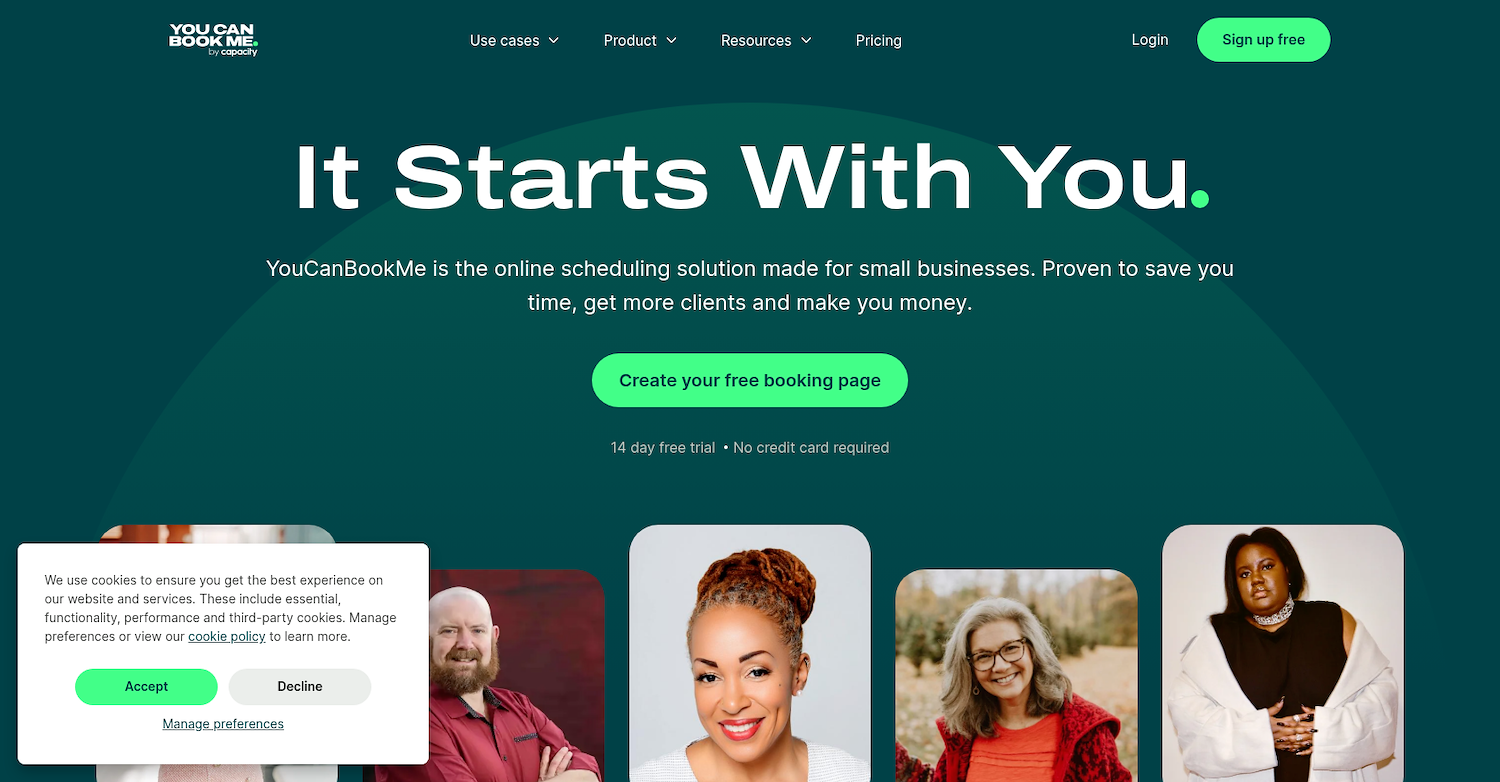
YouCanBook.me is an online tool for appointment schedules that connects to your calendar. It gives clients a personalized page to view your availability and book time directly. The platform is used for customer meetings, recruitment interviews, and client service sessions, which removes coordination emails.
YouCanBook.me's Main Features
- Offers a customizable booking page with multiple display options and personalized notifications.
- Automates tasks such as adding video links, updating the CRM, and tracking no-shows.
- Integrates with Google Calendar and other business applications to reduce manual data entry.
- Provides a personalized scheduling page for clients to book, cancel, and reschedule appointments online.
How YouCanBook.me Compares to Pick
Average Review score: 4.7/5 stars based on 1,923 G2 reviews.
- YouCanBook.me provides a customizable booking page for clients to schedule appointments. This is different from Pick, which is an internal safety tool without client booking options.
- The tool automates tasks such as adding video links to meetings and updating a CRM. Pick does not offer this type of workflow automation, as its focus is on safety alerts.
- It connects directly with a user's Google Calendar to show real-time availability. In contrast, Pick operates as a standalone safety application without calendar synchronization.
- This platform sends automated reminders and follow-up messages for scheduled appointments. Pick's notification system serves a different purpose, designed for safety incidents rather than scheduling.
Where YouCanBook.me Falls Short Compared To Pick
- YouCanBook.me has no features for employee safety. It cannot send emergency alerts or monitor lone workers, which is the primary function of the Pick platform.
- The platform's scheduling tools depend on a reliable internet connection. This may be a problem in remote locations, unlike Pick, which is built to function in low-signal environments.
- This tool is built to manage client appointments. It does not offer any form of personnel tracking for safety, which is a core difference from the Pick system.
Pricing and Cost-Effectiveness
Pick requires a custom quote, making its pricing opaque. In contrast, YouCanBook.me offers transparent pricing with a free plan and paid tiers starting at $7.20 per month. This makes its costs easier to evaluate for budget planning.
9) Schedulicity

Schedulicity is an online appointment scheduling application. It provides a platform for businesses to manage their bookings and for clients to schedule services. The tool is used across various industries for class and appointment management, which helps reduce administrative tasks related to calendar organization.
Schedulicity's Main Features
- Provides a calendar to view appointments, classes, workshops, and personal time in one place.
- Offers access to the calendar on computers, tablets, and smartphones.
- Allows users to access appointment details, including specific notes and client information.
How Schedulicity Compares to Pick
Average Review score: 4.4/5 stars based on 15 G2 reviews.
- Schedulicity provides a calendar to view appointments, classes, and workshops in one place, a feature not found in the Pick safety platform.
- It allows users to access their schedule and appointment details from a computer, tablet, or smartphone, unlike Pick, which uses smartphones for safety alerts.
- The tool shows specific notes and client information for each appointment, whereas Pick does not handle client data because it focuses on employee safety.
- Businesses use the platform to manage bookings and let clients schedule services, a client-facing function that is different from Pick's internal safety system.
Where Schedulicity Falls Short Compared To Pick
- Schedulicity does not provide lone worker safety features. This is a major difference from Pick, which is designed to send alerts and protect employees who work by themselves.
- The tool depends on a stable internet connection for its scheduling functions. This might be a limitation in remote locations, while Pick has features that work in areas with low signal.
- Its platform is built for managing appointments, not for employee safety. Companies that need to monitor staff location for protection will find this a departure from Pick's core purpose.
Pricing and Cost-Effectiveness
Pick requires a custom quote, making its pricing opaque. Schedulicity does not publish its pricing, so for the most accurate information, we recommend visiting Schedulicity's official website.
10) SavvyCal

SavvyCal is a platform to schedule meetings. It lets users share their availability so others can book time slots on their calendar. The tool simplifies the coordination for both the sender and the recipient. It is used for professional appointments and consultations.
SavvyCal's Main Features
- Lets users share scheduling links for recipients to book meetings directly on their calendar.
- Integrates with other business applications to support existing workflows.
- Provides an easy-to-use interface designed to save time on meeting coordination.
How SavvyCal Compares To Pick
Average Review score: 4.7/5 stars based on 35 G2 reviews.
- SavvyCal provides scheduling links for clients to book meetings directly into a calendar. This function is for client interaction, while Pick is an internal tool for employee safety alerts.
- The tool integrates with other business applications to support existing workflows. Pick, in contrast, operates as a standalone safety application without these connections.
- It offers an interface designed to simplify meeting coordination for both the user and the client. Pick's interface serves a different purpose, as it is built for managing safety incidents.
- This platform saves time by automating the process of finding a mutual time to meet. Pick does not offer scheduling automation, as its design centers on lone worker protection.
Where SavvyCal Falls Short Compared To Pick
- SavvyCal does not provide lone worker safety features. This is a major difference from Pick, which is designed to send alerts and protect employees who work by themselves.
- The tool depends on a stable internet connection for its scheduling functions. This can be a limitation in remote locations, while Pick has features that work in areas with low signal.
- Its platform is built for managing appointments, not for employee safety. Companies that need to monitor staff location for protection will find this a departure from Pick's core purpose.
Pricing and Cost-Effectiveness
Pick requires a custom quote, making its pricing opaque. SavvyCal does not publish its pricing, so for the most accurate information, we recommend visiting SavvyCal's official website.
Which One Should You Go With?
Choosing the right Pick alternative involves many variables specific to your organization. This guide has provided a detailed analysis of the top options to help inform your decision.
If your goal is to improve sales productivity, 11x offers a different approach. Its AI agents handle lead generation and outreach, allowing your sales team to focus on closing deals and other high-value activities.


